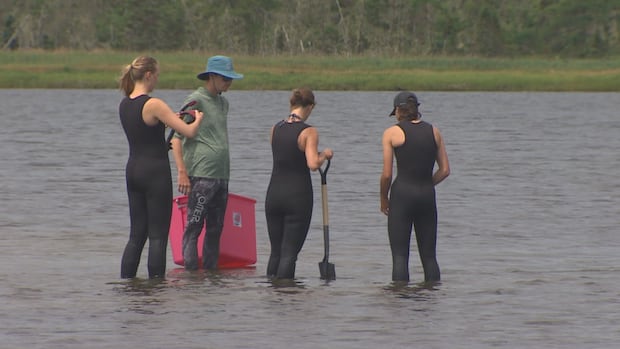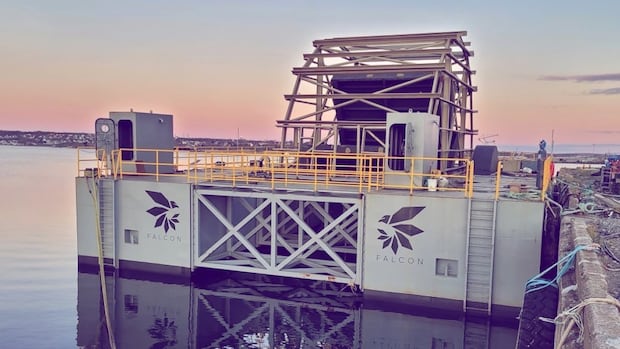Groups conducting coastal restoration in N.S. say they face ‘astonishing’ red tape

Nova Scotia Coastal Restoration Projects Stalled by Permitting Issues
Groups conducting coastal restoration work in Nova Scotia are facing significant challenges due to provincial regulations that are hindering their efforts to support healthy ecosystems. The Community Eelgrass Restoration Initiative, in collaboration with Dalhousie University and the Confederacy of Mainland Mi’kmaq, has been working on eelgrass research and replanting at various coastal sites in the region. However, lead scientist Kristina Boerder expressed frustration over the permitting requirements imposed by the Department of Natural Resources, which have proven to be difficult to navigate.
Boerder highlighted the excessive red tape involved in obtaining permits, especially in contrast to the expedited approval process for large corporate projects. She emphasized the need for a more streamlined approach to permitting for restoration projects, as organizations working on coastal erosion and shoreline cleanups are also facing similar obstacles.
Eelgrass is a crucial habitat for various species, including lobster, juvenile herring, and flounder, while also serving as a natural defense against erosion and a carbon sink. The decline of eelgrass meadows along Nova Scotia’s coastlines has prompted restoration efforts by groups like the Community Eelgrass Restoration Initiative, which involves planting eelgrass blades in shallow waters. However, the group has encountered numerous hurdles in obtaining permits from the Department of Natural Resources to work in submerged Crown land.
Despite their community-led and environmentally beneficial project, the group has faced delays and challenges due to permitting requirements typically associated with aquaculture or construction projects. Boerder expressed frustration over the department’s insistence on respecting riparian rights, which has led to complications in securing permission from coastal property owners.
Tyler Sack from the Confederacy of Mainland Mi’kmaq also raised concerns over permitting issues affecting projects on reserve land, where eelgrass replanting efforts have been met with unexpected regulatory hurdles. While permits have been obtained for current projects, there are fears that similar obstacles may arise in the future, hindering conservation initiatives.
In response, the Department of Natural Resources stated its support for eelgrass restoration but emphasized the importance of following protocols to ensure the protection of Crown land. While the department aims to notify property owners when restoration activities take place in front of private lands, the stringent permitting requirements have posed challenges for community-led restoration projects.
As groups continue their efforts to restore coastal ecosystems in Nova Scotia, advocates are calling for a more collaborative and efficient approach to permitting to facilitate the conservation and protection of vital habitats. By addressing these regulatory barriers, stakeholders hope to overcome challenges and advance restoration projects that benefit both the environment and local communities. The challenges faced by shoreline cleanup groups in Nova Scotia have shed light on the complexities of restoration work in coastal areas. Angela Riley, founder of Scotian Shores, has expressed frustration over the amount of red tape involved in obtaining permits for cleanup efforts. She emphasized that the regulations meant to protect habitats often hinder the cleanup process instead.
One specific example Riley mentioned was the denial of a permit to remove a herring net from a beach due to piping plover nesting season. Despite the good intentions of these groups, they are often met with obstacles that prevent them from carrying out essential cleanup activities.
Nicholas Winkler from the Ecology Action Centre echoed these sentiments, highlighting the need for a regulatory structure that supports restoration work effectively. He emphasized that existing permitting structures are not designed for this type of activity, making it challenging for groups to make a meaningful impact.
The Community Eelgrass Restoration Initiative has also faced difficulties in their efforts, with requests for a conversation with the minister’s office going unanswered. This lack of response is especially frustrating given the government’s commitment to streamlining permitting for other projects like mining.
As these groups continue to navigate the complex regulatory landscape, they hope for a more streamlined process that supports their restoration efforts. By making it easier for projects that work towards the greater good, the government has an opportunity to support environmental initiatives and make a positive impact on coastal habitats. The Benefits of Practicing Mindfulness Meditation
Mindfulness meditation has become increasingly popular in recent years as more people seek ways to reduce stress, improve mental health, and enhance overall well-being. But what exactly is mindfulness meditation and what are the benefits of practicing it?
Mindfulness meditation is a form of meditation where practitioners focus on the present moment and cultivate an awareness of their thoughts, feelings, and sensations without judgment. This practice can be done while sitting, walking, or even eating, and involves paying attention to the breath and bringing the mind back to the present whenever it wanders.
One of the key benefits of mindfulness meditation is its ability to reduce stress and anxiety. By focusing on the present moment, practitioners can let go of worries about the past or future and instead focus on what is happening right now. This can help alleviate feelings of overwhelm and provide a sense of calm and relaxation.
In addition to reducing stress, mindfulness meditation has been shown to improve mental health by increasing self-awareness and emotional regulation. By becoming more aware of their thoughts and feelings, practitioners can better understand their triggers and learn to respond to challenging situations with greater ease and composure.
Furthermore, mindfulness meditation can also enhance overall well-being by promoting a sense of gratitude, compassion, and connection with others. By cultivating a sense of presence and awareness, practitioners can develop a deeper appreciation for the small moments in life and foster healthier relationships with themselves and those around them.
Overall, the benefits of practicing mindfulness meditation are numerous and can have a profound impact on one’s mental, emotional, and physical health. Whether you are new to meditation or a seasoned practitioner, incorporating mindfulness into your daily routine can help you lead a more balanced and fulfilling life.




